Tamil New Year – Tamil Puthandu – Happy Tamil New Year.
The month of April is always close to my heart, because of the car festival at my hometown. Yes, it is the month when Tamil New year is celebrated by Tamilians across the world. This year, it falls on April, 14, which is also widely known as “Chithirai Thirunaal”. Chithirai is the first month in the Tamil calendar and the first day of the month is celebrated as New Year. It is an auspicious festival celebrated as the mark of a fresh beginning of a year.
Back home, Tamil New Year is celebrated like any other festivals – Diwali with new clothes, special food, visiting friends and family. I eagerly wait for this period of the year when I used to go with mom for car festival. That’s the ritual followed in my hometown, Kovilpatti. On the eve of New Year, we used to enjoy the Car festival (Therottam). The Goddess at the temple, Shenbagavalli Amman is decorated and carried in the car on the streets of the town. Thousands of people gather around the temple to have a glimpse of the goddess, worship her and seek her blessings. For us, the festival starts two days earlier. Amma, me and my neighbors discuss and decide about the rangolis and colors to decorate them. The market will be flooded with mango leaves, neem leaves, betel leaves and flowers. Amma usually bought a variety of colors, just for me. Once the Rangolis have been decided, I practice the same in my notebook (not to try directly on the ground and make mistakes). The previous night, around 11 PM, we used to gather in the streets. Wash and clean the front courtyard with water and then, we drew Rangolis. Amma always gave me the front portion and she took the side portion for her rangoli. Once drawn, we sit with our neighbors and color them, which is followed by the inspection of rangolis at other homes. We will finally complete the design with the wish for Tamil New Year as “Puthandu Nalvazhuthukal”. That’s a great sense of satisfaction. I enjoyed those times, chit chat with my neighbors, ordering brothers to color them and rating system at the end.
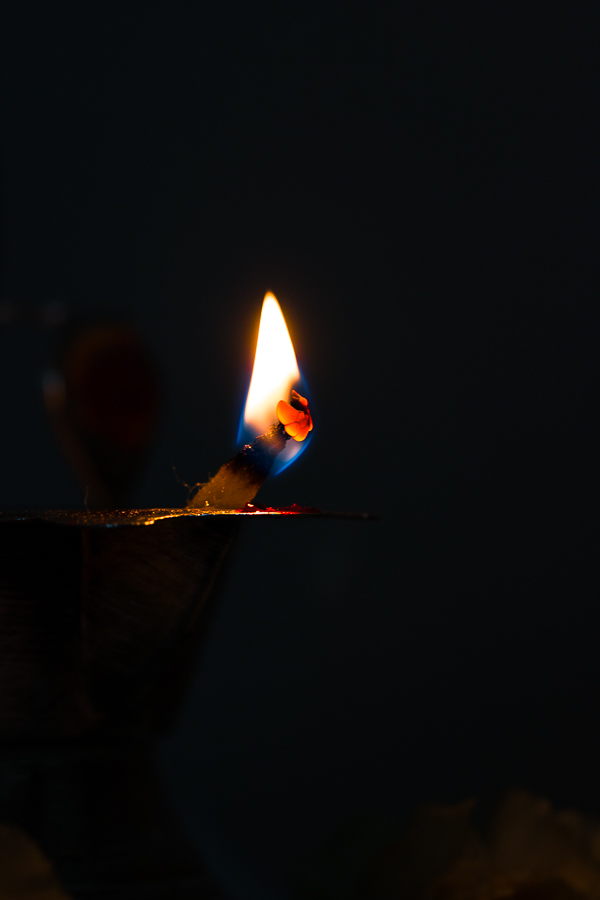
The next day morning, amma wakes up early and prepare for pooja. We will have our head bath followed by pooja and big fat breakfast with vada. The lunch at afternoon will be a traditional south Indian meal. By evening, we will visit the temple, enjoy car festival, gaze around streets, enjoy the rides and munch on snacks at the shops for dinner. It’s been ages that I visited my hometown for Tamil New year and enjoyed car festival. How do I wish to see them again and roam around the streets holding amma’s hands? Someday, I plan to visit and let me kids know as this is how we celebrated Tamil New Year when we were kids. Hope time favors and grants my wish!
This year, I wanted to celebrate Tamil New Year here traditionally and have been preparing for the day. I thought I would mention about the festivals and how it is celebrated in my space as it would benefit novice like me.
The facts are gathered from family and friends.
Preparation:
- Every home is cleaned before the celebration. Some unused and old items are disposed of. Some people repaint their homes before the festival
- The entrance of the house is decorated with Sandal, turmeric, and kumkum
- The front door is decorated with the garland made up of mango leaves.
- The pooja items and lamps are washed and cleaned
- The entrance of the house and pooja room is decorated with colorful Rangolis
On the day of New Year
- People wake up early in the morning before the sunrise and take head bath
- Some prefer to wear new clothes while that’s not followed in many parts.
- Cleaned lamp is lit and placed in the center of the Rangoli which is believed to remove darkness.
- People perform pooja in the morning and do “Kani Parthal”
Kani Parthal:
- Kani Parthal is known as seeing fruits as the first sight in the morning and is considered as auspicious.
- All the pooja items – fruits, rice, pulses, betel leaves, and gold are arranged on the plate and a mirror is placed at the back of the plate. The items on the plate should reflect on the mirror.
- Seeing the fruits in the plate and the mirror together is considered as auspicious and is known as Kani Parthal.
- If one is able to see the real items on the plate and its reflection together at the same time, they are considered to be blessed in abundance. It is told that the wealth will double in the year.
- After taking bath, the family members look at the plate and the mirror, followed by pooja and reading Almanac (Panchangam)
Things needed for Pooja:
- New Almanac (if you have the practice of reading it after pooja. We never do that at our house)
- Mango leaves, for garland at the front door
- Neem leaves and flowers
- Lamp
- Colorful flowers for decorating God and house
- Rangoli powder, for decorating front entrance and pooja room
- Incense sticks
- Fruits – apple, banana, or any available fresh fruits
- Coconut
- Betel leaves
- Rice and Pulses
- Gold or silver jewelry
- New clothes, in case if you wear new clothes. Wear them after pooja.
- There is no particular God to be worshiped on the day. People worship their favorite god/goddess.
Rituals:
- On waking up, family members take head bath and gather together in Pooja room.
- The elder person of the family performs pooja (Appa used to do in our family).
- Food cooked freshly on the day are also offered to God. One should not taste the food before if it is offered to God. People avoid onions and garlic if it is offered to God.
- The lamp is lit by the elder woman in the family followed by offering flowers, breaking of coconuts and an aarti. (lighting the camphor and offering it to God)
- Then, the family members wear new clothes.
- A special recipe for Tamil Ney year – Mango Neem Pachadi (prepared using mango and neem flowers, which has all the six states to denote the various phases of life) is offered followed by a festive meal.
Special recipes:
Tamil New Year is always associated with a big fat traditional meal. It is balanced meal which includes food of all tastes – Neem Mango Pachadi for bitter, kheer for sweet;
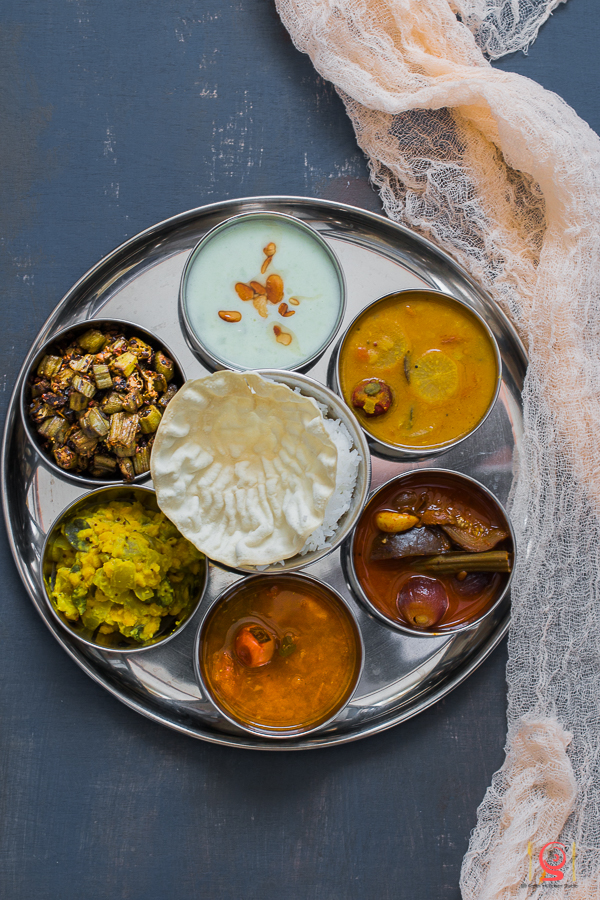
The traditional Tamil Nadu Meals consists of the following
- Pachadi – Mango Pachadi, Carrot Pachadi
- Vada
- Sambar
- Curry
- Rasam
- Poriyal
- Kootu
- Pickle
- Payasam/Kheer
- White Rice
- Appalam /Pappad
- Buttermilk / Curd
This New Year, I am planning to prepare the following recipes. Please find the recipes for the same in the post below (Methi corn dhal vada – I have included the link for the recipe)
- Mullangi Sambar
- Brinjal Drumstick Curry
- Tomato Rasam
- Ridge Gourd Kootu
- Vendaikai Poriyal
- Chow Chow Payasam
- Appalam
- Methi Corn Dhal Vada
Enough of my rants, Here you go, guys
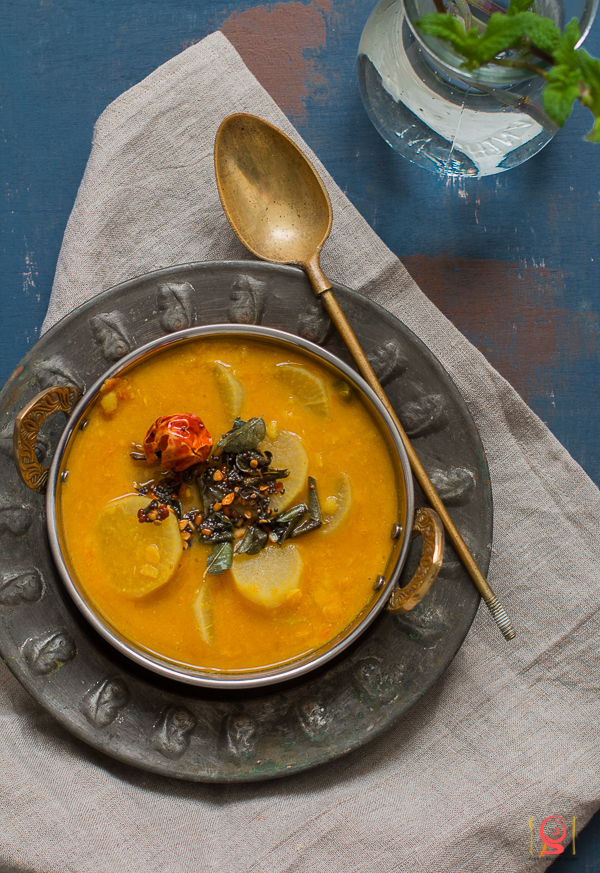
Mullangi Sambar:
Ingredients:
- 1 cup Toor Dhal
- 1 cup Radishes, sliced
- 2 Green Chilies
- 1 Large size Tomato, chopped
- ½ teaspoon Turmeric Powder
- 1 teaspoon Sambar Powder
- Small lemon sized Tamarind
- ½ teaspoon Salt (adjust as per your need)
- 3 cups Water
To temper:
- 1 tablespoon Oil
- ½ teaspoon Mustard Seeds
- ½ teaspoon Urad Dal
- ¼ teaspoon Fenugreek Seeds (Methi seeds)
- 2 Dry Red Chilies
- Pinch of Asafetida
- Handful of Curry leaves
- Handful Coriander leaves chopped
- 2 tablespoon Ghee (optional)
Method: (I haven’t used onions, here)
- Wash Toor dal with water twice and soak it for about 30 minutes.
- Peel the skin of radish and chop them into slices.
- In a pressure cooker, add dal, ¼ teaspoon turmeric powder and a cup of water. Pressure cook it for about 3 whistles. Allow the pressure to release and set it aside
- In a large saucepan/pot, add oil. Once the oil is hot, add mustard seeds, methi seeds, curry leaves, dry red chilies, urad dal, and asafetida. Let it splutter.
- Now, add the chopped radish slices and the spice powders. Stir them. Let the radish slices be combined well with the spice powders.
- Meanwhile, heat a cup of water and soak tamarind in the hot water for about 5 minutes. Extract tamarind juice and discard the pulp.
- Add the tamarind water and another cup of water to the saucepan.
- Cook with the lid covered until the radishes slices are tender.
- Gently add the cooked dhal to the pan and cook until the radish slices are cooked completely.
- Finally, sprinkle the required salt and give a stir.
- Switch off the flame and garnish with handful chopped coriander leaves.
- Add a dollop of ghee on the top for that extra richness.
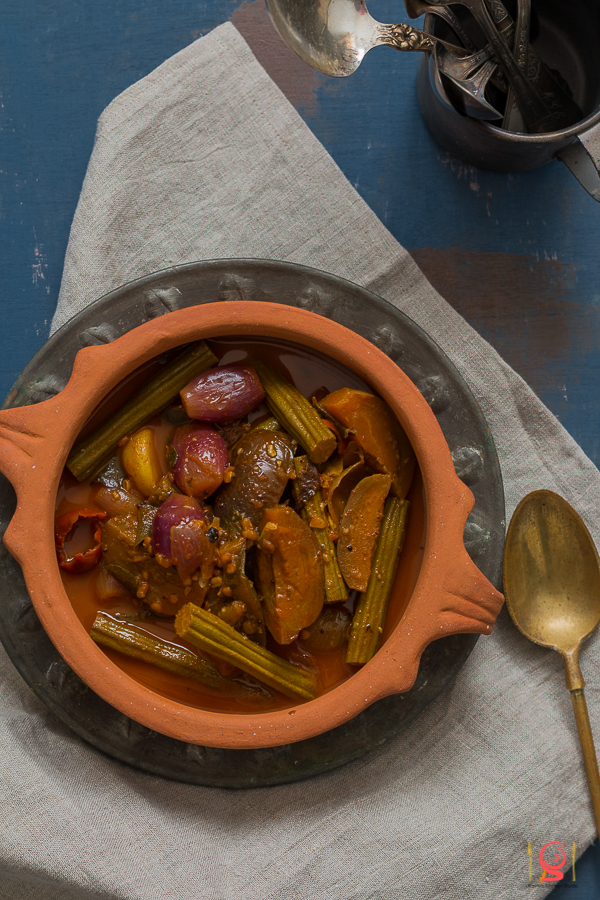
Kathirikai Murungai Puli Kuzhambhu (Brinjal Drumstick Tamarind Curry)
Ingredients:
- 1 cup Brinjals, sliced vertically
- 1 cup Drumsticks, chopped
- 10 -12, shallots (you can avoid this if you don’t prefer onions)
- 1 big lemon sized Tamarind
- ¼ teaspoon Turmeric Powder
- 1 teaspoon Red Chili Powder (adjust according to your desire)
- ½ teaspoon Salt
- 2 cups Water (adjust the consistency of curry based on your desire. If you prefer watery, add more water)
To Temper:
- 1 tablespoon Gingelly Oil
- ½ teaspoon Mustard Seeds
- ½ teaspoon Urad Dhal
- ¼ teaspoon Fenugreek seeds
- ½ teaspoon Cumin seeds
- Handful Curry leaves
- 2-3 Dried Red Chilies
Method:
- Wash brinjals and drumstick with water and chop them into uniform pieces. I usually cut brinjals into four.
- Peel the shallots and chop them. I prefer them as a whole.
- In a non-stick wok, add oil. Once the oil is hot, add mustard seeds, urad dhal and allow it to splutter.
- Add curry leaves, methi seeds, cumin seeds, dried red chilies and give them a stir. Let it crackle and turn light brownish.
- Slide in the chopped vegetables and add spice powders.
- Gently combine them well and cook on medium flame until the brinjals become tender. One can see the skin of brinjals turn color. Stir them occasionally to avoid vegetables being burnt at the bottom
- Meanwhile, heat a cup of water with tamarind. Extract the tamarind juice and discard the pulp.
- Now, add the tamarind juice to the wok. Sprinkle the required amount of salt and give it a stir.
- Cook with the lid covered in medium flame until the vegetables are cooked completely and oil separates on the sides.
- Remove the curry from the flame and let it rest till you serve.
- Ensure to cook the curry on medium to low flame for the better taste. Let it cool down completely before your serve. The curry tastes exquisite the next day.
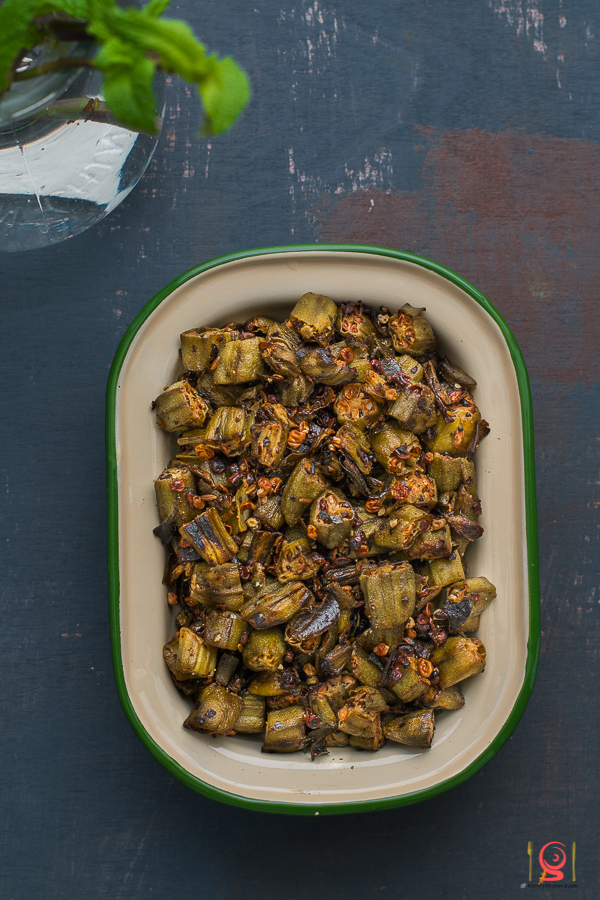
Vendaikai Poriyal
This is a simple stir-fry and tops my list of favorites.
Ingredients:
- 25 – 30 Okras/Vendaikai/Lady’s finger, chopped into slices
- ½ teaspoon Curd
- 1 tablespoon Oil
- ½ teaspoon Mustard Seeds
- ½ teaspoon Urad dhal
- Handful Curry leaves
- 1 tablespoon cumin seeds
- ½ tablespoon Black Peppercorns
- ½ teaspoon Salt
Method:
- Wash the Okras with water and spread them on a plate. Allow it to dry.
- Once dried, chop them into slices and again spread them on a wide plate.
- Let it rest for an hour or two. (I usually do this as a first activity in the morning and leave it to dry. This will reduce stickiness of the vegetable to a certain amount)
- In a non-stick wok, add oil and heat it over medium flame. Once the oil is hot, add mustard seeds, urad dhal, and curry leaves. Let it splutter.
- Now, increase the flame and add chopped okra pieces.
- Fry them in high flame. This helps to reduce the stickiness in okra.
- When it starts to stick, add curd and combine them well. One can add curd or rice powder to reduce the stickiness
- Fry until the stickiness reduces. Reduce the flame to medium and cook with the lid opened until the okra pieces are cooked. Sprinkle the required salt and combine them well
- Meanwhile, in a blender jar, add cumin seeds and peppercorns. Grind them into a coarse powder.
- Now, add the grounded powder to the fried okras and cook them in low flame for about 5 minutes. Adjust the spiciness according to your desire. I prefer it spicy, hence added the entire amount of powder
- Switch off the flame and serve it with sambar.
- Sometimes, I dry roasted peanuts and add them with fried okra pieces along with grounded powder. You can give peanuts a try if you love.
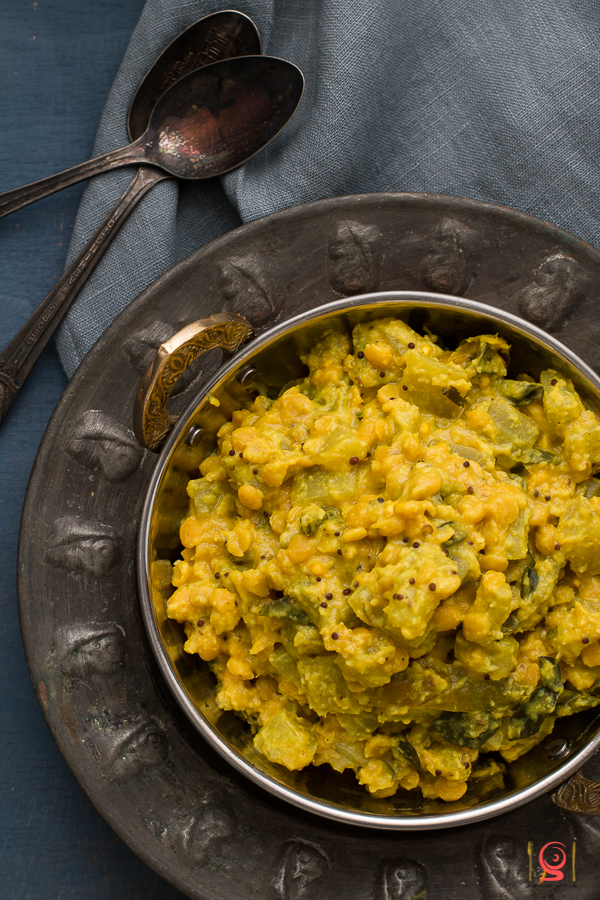
Sorakkai Kootu
Ingredients:
- 1 medium sized Bottlegourd, cleaned and chopped into pieces
- 1 cup Channa Dhal
- ½ teaspoon Turmeric Powder
- 1 tablespoon Oil
- ½ teaspoon Mustard Seeds
- ½ teaspoon Urad Dhal
- Handful Curry Leaves
- 3-4 Green Chilies, slit into halves
- ½ teaspoon Cumin Seeds
- ¼ cup Grated Coconut
- ½ teaspoon Salt
- 2 cups Water
Method:
- Soak Chana dhal for about 30 minutes. Wash the dal completely and drain the excess water.
- Pressure cook dal with turmeric powder and a cup of water for about 3 whistles.
- Allow the pressure to release and set aside.
- In a non-stick wok, add oil and heat it over medium flame.
- Once the oil is hot, add mustard seeds, urad dal, curry leaves and allow it to splutter.
- Now, add green chilies and fry them for a minute.
- Gently, slide in the chopped vegetable and combine them well.
- Add a cup of water and cook with the lid covered until they are half cooked.
- At this stage, add the cooked dhal and cook with the lid covered until the vegetable is completely cooked and water is absorbed completely. Add 1-2 tablespoon of water if the veggies are getting burnt at the bottom.
- In a blender jar, add coconut and cumin seeds. Grind them into a fine paste.
- Add the grounded paste to the pan and cook them for about 5 minutes.
- Season it with the required amount of salt
- Switch off the flame and serve the kootu with sambar for rice.
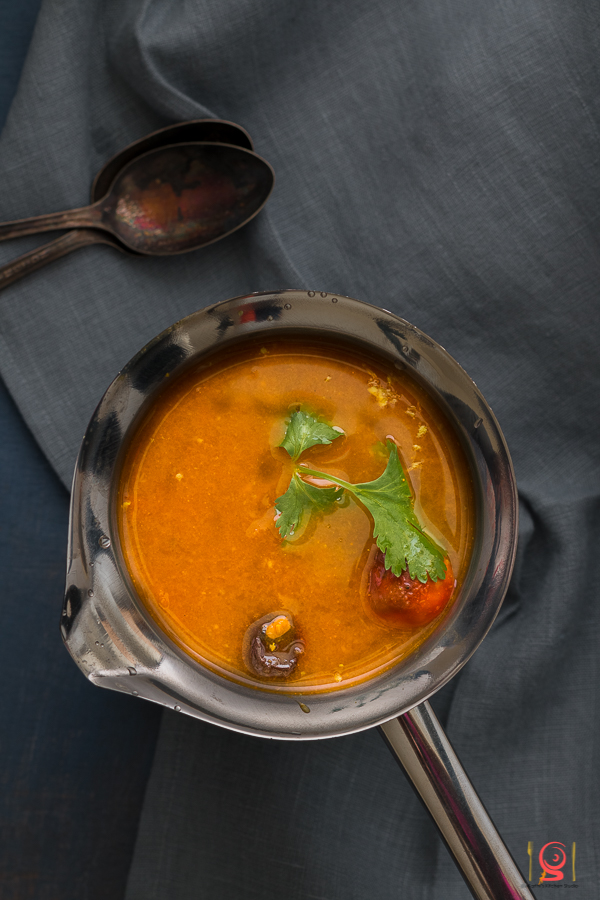
Tomato Rasam:
Ingredients:
- 3 large Tomatoes
- Half small lemon sized Tamarind
- 1 tablespoon Ghee
- ½ teaspoon Mustard seeds
- ½ teaspoon Urad dal
- 2 Dried Red chilies
- 2 Green Chilies
- ½ teaspoon Cumin Seeds
- ½ teaspoon Pepper Corns
- 3-4 Garlic Cloves
- ¼ teaspoon Turmeric Powder
- 3 cups of water
- ½ teaspoon Salt
- Handful Chopped Coriander Leaves
Method:
- Blanching the Tomato:
- In a small pot, add water and 2 tomatoes. Bring it to boil and cook until the skin of tomato becomes tender and peels off.
- Drain the water from the pot. Remove the skin from the tomato and gently mash them with hand.
- Meanwhile, heat a cup of water with tamarind and extract tamarind juice. Discard the pulp.
- In a vessel, add mashed tomatoes, tamarind juice, and turmeric powder. Season it with the required amount of salt. Combine them well and set it aside.
- Heat a medium sized pan/vessel and add ghee. Allow it to melt.
- Add mustard seeds, urad dal, curry leaves and dried red chilies. Let the mustard seeds crackle.
- Chop the remaining tomato into slices.
- Slide in the green chilies and tomatoes and give them a stir.
- Now, gently pour the tomato-tamarind mixture to the pan and bring it to boil.
- Once it starts boiling, add the remaining cup of water and cook until the froth forms at the top. Ensure not to boil the mixture. Remove from the flame immediately once you start seeing froths on the sides/top.
- Once removed from the flame, add chopped coriander leaves and set aside.
- Ensure not to boil the rasam!
Chow Chow Payasam
I heard you. It might sound ridiculous but then I loved it.
Ingredients:
- 1 Chow Chow, chopped into pieces
- 1 ½ cup Milk
- 1 cup Water
- ½ cup Sugar, adjust as per your desire.
- ¼ teaspoon Cardamom Powder
- 1 teaspoon Ghee
- 1 teaspoon Cashews
- 1 teaspoon raisins (optional)
- Green color Food Color (optional)
Method:
- In a pressure cooker, add chow chow and water. Pressure cook them for about 3 whistles.
- Allow the pressure to release and set aside. Let it cool down.
- Once cooled, grind them into fine paste in a blender
- In a small pot, add milk and the grounded paste. Bring it to boil. Stir them frequently to prevent burning at the bottom.
- Add sugar and cook with frequent stirring until the milk reduces to half.
- Season it with cardamom powder.
- In a small pan, heat ghee and roast cashews until it becomes brownish.
- Add the roasted cashews to the payasam and remove it from the flame.
- Serve it warm or chilled.
Are you interested in preparing other combinations, then do check out other recipes available in the space!
Sambar – Thatta payaru Sambar
Curry – Vendaikai Puli Kuzhambhu, Spicy Brinjal Potato Curry, ChickPeas Spicy Curry, Spicy Brinjal Curry
Kootu – Kathirikai UrulaiKizhangu Pachidi
Poriyal – Aloo Gajar Sabzi (no onion no garlic), Snake Gourd Thoran, Kaya Tholi Thoran, Cabbage Carrot Thoran, Beans and Carrot Poriyal
– Payasam Appe Payasa, Vermicelli Kheer, Dry Dates Kheer
Vada – Methi Corn Dal Vada, Sago Vada, Ambode
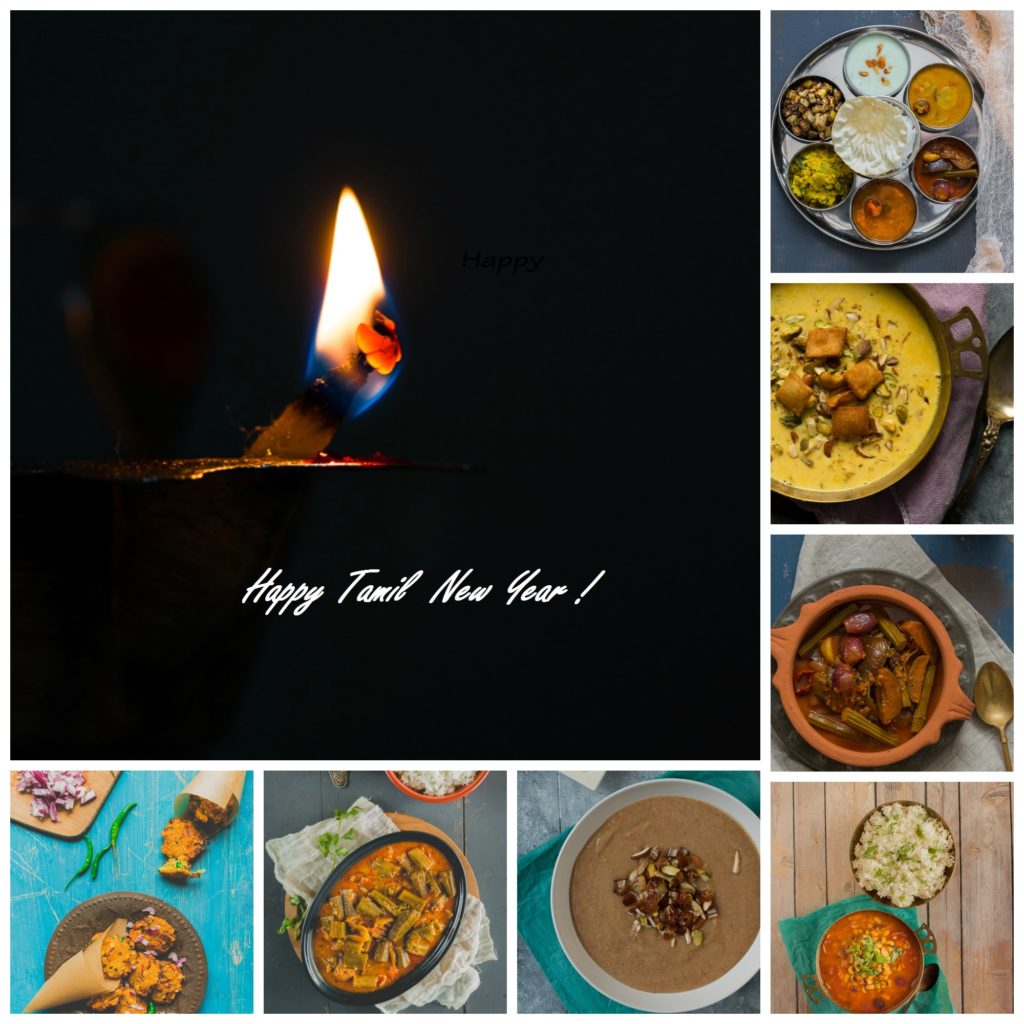
If you try the recipe, do let me know how they tasted in comments. If you like space, do like and follow my profile at here – Facebook, Google
Yours Truly,
Karthi

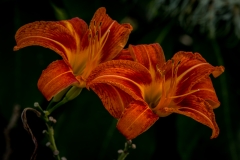
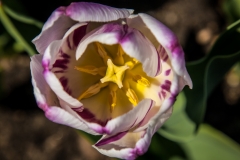






Perfect south Indian lunch. Had a great time in home.
Yeah, the lunch turned awesome and the avial was perfect!